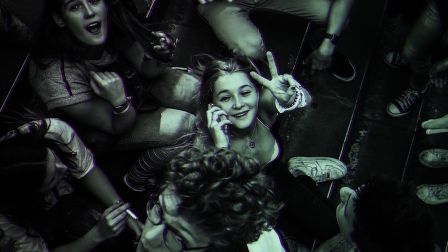Born In Between Generations? Here’s How It Can Help Your Career
Helen Phung, a communications consultant, had what she considered a brilliant Halloween costume. She couldn’t wait for her coworkers to give her knowing nods and make clever comments as they passed her in the kitchen. She was dressed as the Chicken Lady from Kids in the Hall, the Canadian sketch comedy show that originally aired from the late ’80s to mid-’90s, and later as reruns on Comedy Central during the ’00s.
When Phung strolled into her office wearing her pink and white masterpiece, ready to score points and winks, she recalls, “No such thing happened. No one knew who I was, nor did they think it was funny. I ended up having to say emphatically, ‘I’m the Chicken Lady from Kids in the Hall! You don’t know the Chicken Lady!? Oh, you’ve never seen Kids in the Hall? Okay. Cool. Well, it was hilarious. You should YouTube it.’”
Then she admits, “This led to a compounded feeling of alienation.”
Phung’s experience may sound simply like a case of generational differences. And maybe that’s true. But for Phung, who was born on the cusp of both the millennial generation (born 1981–2001) and the tail end of generation X (born 1965–1980), her own generational position isn’t so clear.
Like her, some generational “in-betweeners” in the workplace today may feel puzzled by Snapchat, yet were too young to listen to Nirvana and wear Doc Martins and flannels the first time around. Or else they’re older members of gen X, who feel a little too old to identify with their Reality Bites peers but a little too young to throw in with the baby boomers (born 1946–1964) now in the midst of retirement planning.
This matters because, for better or worse, we’re obsessed with dividing up our workplaces along generational lines. There’s no shortage of professional hand wringing over what millennials supposedly want and require as their careers continue to advance. Much of that anxiety is driven by heaps of research that may help catalogue a given demographic’s preferences and attitudes right now, but isn’t so great at determining whether those are distinctly generational characteristics. This leads to at least as much stereotyping as genuine understanding. And ordinary employees, hemmed in by age-based assumptions, either need to use those caricatures to their advantage in the workplace or else suffer from them.
For those who were born squarely within one generational cohort, these aren’t great options. But it isn’t much better for those who weren’t. Sure, dressing like the Chicken Lady and being met with blank stares is embarrassing, but people like Helen Phung don’t just have to leave their niche Halloween costumes at home and feel out of place at work. They may actually be able to take the experience of being between generations and use it to their advantage.

Bridging The Gap
One benefit of being between generations is obvious. “Being a generational “in-betweener” helps me connect with a broader cross-section of people than I might otherwise,” says Fennemore Craig attorney James Goodnow, who was born in 1981.
He feels he’s better able to act as a quasi-translator between generations, much the same advantage that business futurist Alexandra Levit says gen Xers are now poised to take advantage of en masse. Like those born in between generations, gen X is a considerably smaller cohort than the two big generational blocs on either side. As baby boomers phase out of the workforce, Levit believes gen X professionals may be able to bridge the communication divide between those veterans and the swelling ranks of younger workers.
The experience Goodnow describes is similar. “I think being on the cusp of different generations provides a distinct advantage,” he says. “It makes it a bit easier to understand the attitudes, opinions, and perspectives of a larger group of people.” After all, communication breakdowns don’t just emerge between one generation and one that’s two spots down the line, but also between one generation and the one directly behind it.
Unexpected Management Chops
Jeremy Hill, who was born smack dab between gen X and gen Y (millennials), in 1980, believes his experiences ultimately made him a better manager. Getting there wasn’t an easy process, though.
When Hill graduated with a computer science degree, Y2K was a big concern . To prepare for the possibility of an impending technological disaster, his university required students to learn an “antiquated language” so they could retrofit banking and health care applications. So despite learning the latest and greatest coding languages, Hill’s first job was writing an old code: Fortran 77. Here’s how he recounts his first job experience:
The next-youngest person in that IT department was over twice my age. These men had grown up coding in Fortran 77 their entire lives, and it was all they knew. Everything was done in this ancient language, partly because they didn’t really want to go through the hassle of changing it all up, but also because it meant job security for them.
It was a complete nightmare for me. As much as I tried to drag them into the 21st century, they resisted at every turn. I ended up very much isolated, and as soon as was feasible, I applied for any and every job I could think of.
Now that Hill is further along in his career, he says, “I find myself now playing the role of the old coot.” For example, when his team went to see the new Star Wars movie together, Hill told them how the last time he’d been in line for a Star Wars movie was 1999. “And they all just looked at me as if I had said 1899.”
But as a senior engineer, Hill’s past experience as the onetime youngest guy on an immovable team comes in handy. He’s more open to ideas than the older coworkers he used to have, yet history and experience keep him realistic. “The new guys all turn to me for advice and major decisions,” he says, “because I have done my time in the trenches and can hopefully spare them any agony.”

Being The First Passengers On The Tech Train
Technology prowess is often a point of contention between generations, and sometimes it’s used as a pretext for age discrimination (as I’ve written previously for Fast Company with regard to the term “digital natives”). But Jessica Reeder, on the younger end of gen X, feels like being in the front car of the technology train helped her one-up her millennial peers.
“I was an early adopter of Myspace, Friendster, Twitter, Facebook, and a beta Gmail user,” she explains. “I taught myself HTML, CSS, and WordPress and built websites for good money. Then I went on to be a community manager at social networks like Meez and MOG. All those inroads kept me well ahead of the curve at crucial points throughout my professional development.”
Reeder points out a great benefit to living in the gray area between generations X and Y: “I also had the luxury of trying those new things when the internet was relatively young, so most of my youthful mistakes are not on public display!”
Blessing And Curse
One true advantage to being sandwiched in between generations is simple: a wider perspective. Nick Braun, founder and CEO of PetInsuranceQuotes.com, says it well: “Being able to bridge two generations gives me a 40-year perspective on consumer behavior and market trends, not just 20. And we’re empathetic to those both older and younger, which is a huge advantage.”
That broad perspective can be frustrating as well, though. Nicole Lazar of the Nth Element, born in 1982, between gen X and gen Y, puts it this way:
I consider myself old-school, where I want to have real conversations with my clients and coworkers, not send a text. In today’s professional world, this is becoming more scarce. In reality, my clients respond quicker via text or Facebook messaging, but the personal relationships I built my company on are dying. No longer do they look at my business as a loyal partner they can trust and rely on, but as a simple “service.”
However, Lazar says, “Recognizing this, I still feel like that is my competitive edge today.” She finds that most people in her industry don’t hold meetings anymore or focus on the impact of personal relationships. Lazar’s generation of professionals still appreciate that, though, so she makes sure to drop in for face time (not just FaceTime) as often as she can.
In a way, we can look at those born between generations as torch bearers. The more baby boomers that retire, the more the workforce loses not just knowledge capital but also cultural capital. It’s the in-betweeners who may be best positioned to preserve the best qualities of the preceding generation in their companies’ cultures.
And all the while, they can also help us see past the assumptions we’re often too keen to make about what people belonging to one generation or another are supposed to be like. After all, it’s never just our ages or birth positions that sometimes leave us feeling alienated at work (if only it were). At some point or another, we all find ourselves feeling like the only one in a hilarious Halloween costume no one else gets. It’s what we do with that feeling that counts.
Anne Loehr is a speaker, writer, consultant, and trainer. She helps leaders in large organizations connect their everyday decisions today to the workplace of tomorrow. Follow Anne on Twitter at @anneloehr.
Fast Company , Read Full Story
(60)


